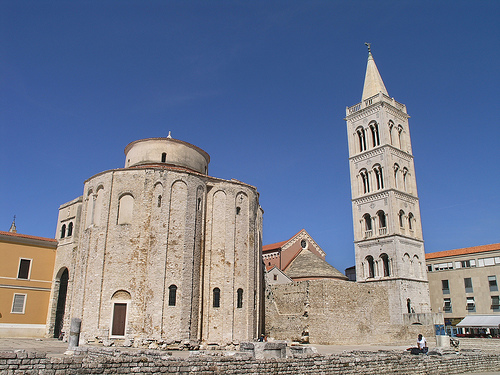

The Church of Saint Donatus, located in the historic center of Zadar, Croatia, is a striking example of Pre-Romanesque architecture and one of the city's most iconic landmarks. Originally dedicated to the Holy Trinity, it was later renamed in the 15th century after Bishop Donatus of Zadar, who is credited with its construction in the early 9th century. This circular church stands on the ruins of the ancient Roman forum, incorporating materials from that era, and represents a blend of Byzantine and Carolingian influences. It is no longer used for religious services but serves as a cultural venue, particularly known for its exceptional acoustics that make it ideal for concerts.
Construction of the Church of Saint Donatus began in the second half
of the 8th century and was completed in the early 9th century under the
direction of Bishop Donatus, a prominent diplomat born around the late
8th century, possibly from a notable Zadar family. Donatus played a key
role in international affairs, representing Dalmatian cities in
negotiations with Byzantine Emperor Nikephoros I in Constantinople in
804 and with Charlemagne (Charles the Great) in 811, contributing to the
Peace of Aachen in 812, which granted autonomy to Zadar and other
Dalmatian cities under Byzantine suzerainty. He is said to have died
around 811 and was initially buried in the church, though his remains
were later transferred to the Cathedral of St. Anastasia in 1809 during
the French occupation.
The church was first mentioned around 950 in
Byzantine Emperor Constantine Porphyrogenitus's work "On the
Administration of the Empire." Over the centuries, its function evolved
significantly. It served as a place of worship until 1798, after which
it was desacralized. During the rule of the Republic of Venice, the
French Napoleonic period (1806–1813), and Austrian rule, it was
repurposed as a warehouse. From 1893 to 1954, it housed the Zadar
Archaeological Museum under Austrian, Italian (1918–1943), and
Yugoslavian administrations. After Zadar's annexation to Yugoslavia, it
briefly continued as a museum before transitioning to its current role
as a concert hall. Bishop Donatus also brought relics of St. Anastasia
and St. Chrysogonus from Constantinople, enhancing Zadar's religious
heritage and linking the church to the broader episcopal complex,
including the early Christian cathedral and bishop's palace.
The Church of Saint Donatus is the largest Pre-Romanesque building in
Croatia, exemplifying the centralized, circular style typical of
Carolingian architecture in early medieval Europe. Standing at 27 meters
high, it features a double-ring structure with a formerly domed roof,
characterized by simplicity and a certain technical primitivism. The
design includes three radially situated apses and an ambulatory
encircling the central area, topped by a circular gallery. This circular
form is unique to early medieval Dalmatia and draws influences from
Byzantine traditions, with resemblances to Charlemagne's court chapel in
Aachen (now part of Aachen Cathedral) and the Basilica of San Vitale in
Ravenna.
Built directly on the northeastern part of the Roman forum,
the church extensively reuses ancient materials, such as stone
fragments, pillars, capitals, and architraves from Roman structures. The
foundations expose these elements, including remnants of a sacrificial
altar inscribed with dedications to the Roman gods Juno and Jupiter
("IVNONI AVGUSTE IIOVI AVGUSTO"). The original floor has been removed,
revealing panels from the ancient forum below. Notably, the church is
not fully preserved in its original form; a southern annex was
demolished in 1930.
The exterior is dominated by its robust, cylindrical shape with thick stone walls, arched windows, and a simple, unadorned facade that emphasizes its medieval origins. The entrance portal is framed by ancient stone beams, and the base integrates visible Roman ruins, including broken columns and stone blocks scattered around the site. Its location amid the Roman forum remnants adds to the layered historical texture, with the church rising prominently against the surrounding structures.
Inside, the church maintains a minimalist aesthetic, with a central nave surrounded by the ambulatory and an upper circular gallery. Key features include two Roman columns positioned in front of the main apse and the main altar, under which Bishop Donatus's remains were placed in 1622 during the time of Archbishop Stella. The interior's acoustics are renowned, allowing sound to resonate clearly throughout the space, which has made it a favored venue for musical performances. There are no elaborate frescoes or decorations, aligning with the Pre-Romanesque style's emphasis on structural form over ornamentation.
As one of the most monumental Croatian buildings from the early Middle Ages, the Church of Saint Donatus holds immense cultural and architectural importance. It symbolizes Zadar's rich history as the oldest continuously inhabited city in Croatia, bridging Roman, Byzantine, and medieval eras. The church's design reflects broader European architectural trends of the Carolingian period, highlighting diplomatic and cultural exchanges between the Franks, Byzantines, and local Dalmatian entities. It is part of Zadar's episcopal complex, which is on UNESCO's Tentative List for World Heritage status, underscoring its global historical value. Additionally, its connection to Bishop Donatus, who facilitated the veneration of key saints in Zadar, adds to its religious and historical legacy.